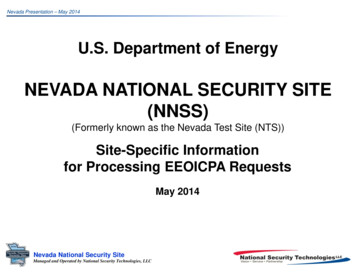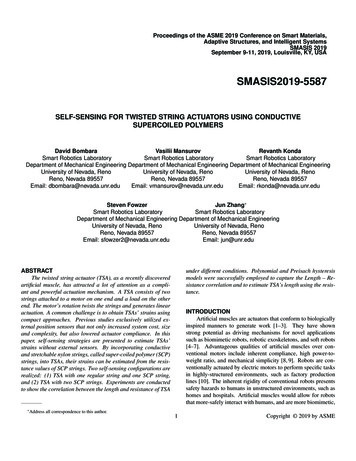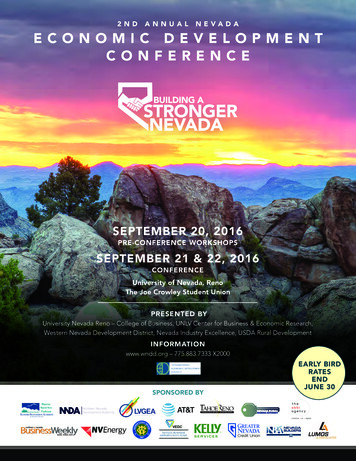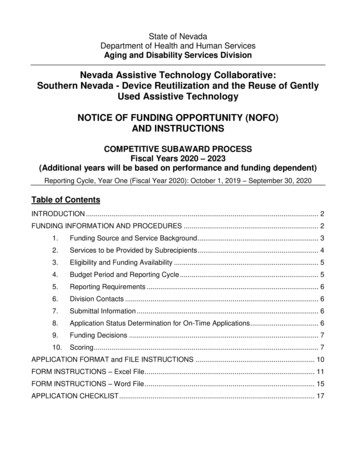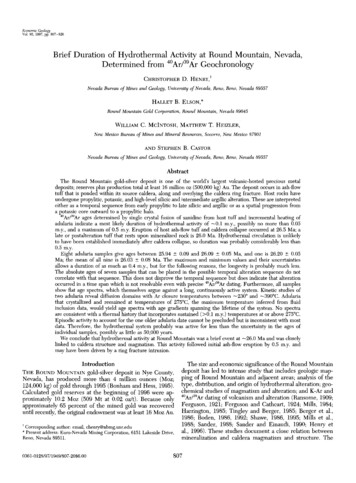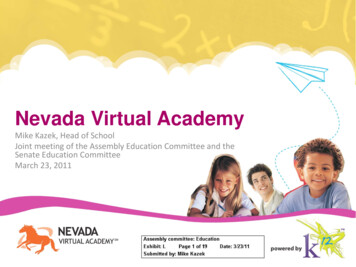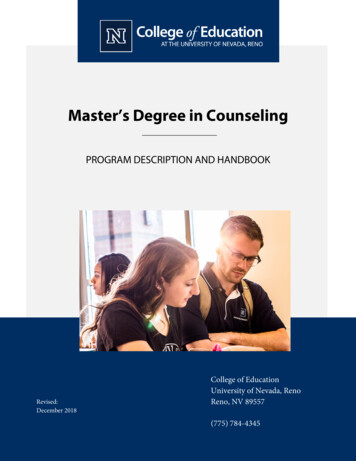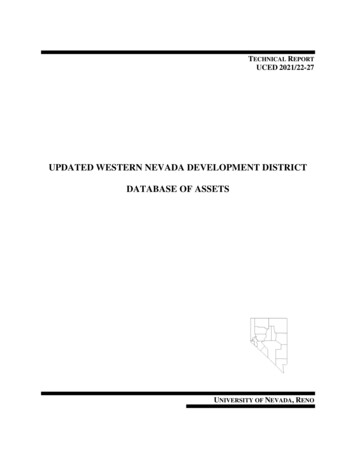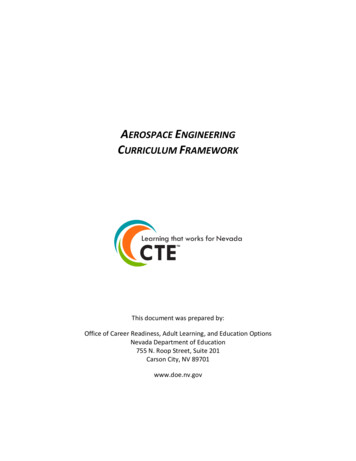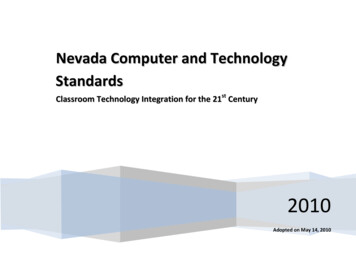
Transcription
Nevada Computer and TechnologyStandardsClassroom Technology Integration for the 21st Century2010Adopted on May 14, 2010
Nevada Department of Education700 East Fifth StreetCarson City, NV 89701www.doe.nv.govDr. Keith W. RheaultState Superintendent of Public InstructionGloria DopfState Deputy Superintendent of Public InstructionCarol CrothersDirector of Assessment, Program Accountability, andCurriculumDr. Kimberly VidoniEducational Technology Consultant1
Table of ContentsThe Nevada Computer and Technology Standards . 3Introduction . 36.Glossary . 18Acknowledgements . 19ISTE NETS‐S . 3Standards for Classroom Technology Integration . 3Standards for 21st Century Classrooms . 3Contents of this Document . 4How to Read this Document . 4Nevada Computer and Technology Standards . 4Glossary . 4Acknowledgements. 4How to Read this Document . 5Nevada Computer and Technology Standards . 61.Creativity and Innovation . 62.Communication and Collaboration . 83.Research and Information Fluency . 104.Critical Thinking, Problem Solving, and Decision Making 125.Digital Citizenship . 14Technology Operations and Concepts: . 162
The Nevada Computer and TechnologyStandardsIntroductionTo ensure that Nevada students are prepared for life in the digitalage, students must be proficient technology users. It is no longeradequate for instruction to focus solely on basic technology skills aswas the basis of previous versions of the Nevada Computer andTechnology Standards. Rapid changes in our global society andtechnological advancements warrant changes to the waystechnologies are integrated into classroom instruction. Thestandards contained in this document still address basiccompetence, and also incorporate the skills and knowledge thatstudents require to learn effectively and live productively in anincreasingly digital society.Standards for Classroom TechnologyIntegrationThe Nevada Computer and Technology Standards are unique in thatthey are not content standards. They are simply standards. Thenotion of technology integration suggests that technology taught inisolation is not as effective as when technology is used in context.For instance, teaching students how to conduct Internet researchwithout a topic to research does not carry the same rigor orrelevance as conducting a web search for information on theGettysburg Address to write a history report. Therefore, thestandards in this document are simply standards, not contentstandards, and the content is derived from the subject areas inwhich they are integrated. The intent is to create a set oftechnology standards that could be easily integrated into anycontent area or incorporated into the content standards of othersubjects.ISTE NETS SThe 2009 Nevada Computer and Technology standards are based onthe National Educational Technology Standards for Students (NETS‐S) put forth by the International Society for Technology in Education(ISTE). The format of the NETS‐S adapts well to the format of theprevious standards, but stops short of assigning indicators tospecific grade bands. Therefore, the national indicators takes therole of strands and Nevada indicators demonstrate how the NETS‐Sshould be applied within specific grade bands in Nevada.Standards for 21st Century ClassroomsAcross the globe and in Nevada, growth in technology hastransformed every aspect of business, government, society and life.Education must adapt to these changes, as well. Effective classroomtechnology integration is the bridge that invites millennial learnersto be successful, engaged, classroom learners. The standards in thisdocument are written to assist district and school staff in thedevelopment of curriculum that will help build that bridge.3
Additionally, once adopted, standards bear a 5‐7 year lifespan.Technology changes rapidly and to accommodate this, thestandards and indicators in this document are not specific to thetechnology, but are specific to the process of classroom technologyintegration and creating a 21st century learning experience forNevada students.Contents of this DocumentHow to Read this DocumentGlossaryA glossary has been provided to establish a common vocabularyamong all Nevada educators, students, and parents. This sharedvocabulary provides a foundation for consistent practice across thestate.AcknowledgementsThe acknowledgement pages express appreciation to all participantswho helped with this document.This section will describe the components of the standards sectionwith accompanying definitions, language, and position of elements.According to this page, a standard is the overall description of thelearning objective, strands are skill subsets that help define thestandard, and indicators are the specific learning expectations ateach grade level.Nevada Computer and Technology StandardsStandards describe what students need to know and be able to doat each grade level. In Nevada, these standards are considered thefloor, not the ceiling, for student learning and performance. Thisdocument serves as a framework to guide districts in creating theircurriculum based on the state standards. It is essential that thestandards are not taught in isolation; rather, multiple standards aretaught within a single lesson ensuring teachers, students, andparents make the connections between reading and writing toenhance performance.4
How to Read this DocumentThe chart below represents a typical page in Nevada Computer and Technology standards. The information below is provided to assist withreading this ication and Collaboration: Students use digital media and environments to communicate and work collaboratively, including at a distance, tosupport individual learning and contribute to the learning of others.National Indicator25812B. Communicate informationand ideas effectively tomultiple audiences using avariety of media and formats.2.B.2.1Communicate information andideas to peers and parents usingdigital text and illustrations.2.B.5.1Communicate information andideas using digital text, images,and sound.2.B.5.2Describe appropriate media andformats for specific audiences.2.B.8.1Communicate using digitaltext, images, sound, and video.2.B.8.2Create digital products informats appropriately targetedto specific audiences orpurposes.Nevada IndicatorStandard. National Indicator. Nevada Indicator. Indicator Number52.B.12.1Create digital text, images,sound, and video for use incommunication.2.B.12.2Critique appropriateness ofdigital formats for audiencesand purposes.Grade by which students shouldknow the material covered in theindicators in that column by thetime they complete that grade.Students are required to know allindicators of all previous grades aswell.
Nevada Computer and Technology Standards1. Creativity and Innovation: Students demonstrate creative thinking, construct knowledge, and develop innovative products andprocesses using technology.National Indicator258121.A.12.1Apply new and existingknowledge toindependently, or incollaboration with others,generate new ideas,products, or processes withdigital tools.1.B.12.1Create an original workusing digital tools,including planning,research, editing, andproduction.A. Apply existingknowledge to generate newideas, products orprocesses.1.A.2.1Use digital tools tobrainstorm and organizenew ideas.1.A.5.1Process new ideas basedon existing knowledge tobrainstorm solutions to anauthentic problem usingdigital tools.1.A.8.1Apply existing knowledgeto independently generatenew ideas, products, orprocesses with digitaltools.B. Create original works asa means of personal orgroup expression.1.B.2.1Create an original workusing a variety of digitaltools as a means ofpersonal or groupexpression.1.B.5.1Create an original, digitalwork as a form of personalor group expression withminimal teacher support.1.B.8.1Create an original, digitalwork as a form of personalor group expression.C. Use models andsimulations to explorecomplex systems andissues.1.C.2.1Use digital models andsimulations with teacherassistance.1.C.5.1Use digital models andsimulations to explorecomplex systems andissues.1.C.8.1Use digital models andsimulations to answerquestions or to solveproblems.61.C.12.1Develop digital models orsimulations to answerquestions or to solveproblems.
National IndicatorD. Identify trends andforecast possibilities.21.D.2.1Identify patterns andpredict possibilities withclassroom data usingdigital tools.51.D.5.1Identify and representtrends and makepredictions usingclassroom data.78121.D.8.1Use technology to tracktrends and predictpossibilities usingevidence, experiments, andcollaboration to justifytheir predictions.1.D.12.1Use technology toresearch, conduct, andreport experimental data,to determine trends andpossibilities using evidenceto justify their predictions.
2. Communication and Collaboration: Students use digital media and environments to communicate and work collaboratively,including at a distance, to support individual learning and contribute to the learning of others.National Indicator25812A. Interact, collaborate,and publish with peers,experts, or othersemploying a variety ofdigital environments andmedia.2.A.2.1Work in classroom groupsto create and publishdigital products.2.A.5.1Collaborate to create andpublish digital products toshare beyond theclassroom.2.A.8.1Collaborate to create andpublish digital products forauthentic audiences in avariety of digitalenvironments.2.A.12.1Collaborate electronicallywith peers, experts andothers to create and publishdigital products forauthentic audiences.B. Communicateinformation and ideaseffectively to multipleaudiences using a varietyof media and formats.2.B.2.1Communicate informationand ideas to peers andparents using digital textand illustrations.2.B.5.1Communicate informationand ideas using digital text,images, and sound.2.B.8.1Communicate using digitaltext, images, sound, andvideo.2.B.12.1Create digital text, images,sound, and video for use incommunication.2.B.5.2Describe appropriatemedia and formats forspecific audiences.2.B.8.2Create digital products informats appropriatelytargeted to specificaudiences or purposes.2.B.12.2Critique appropriateness ofdigital formats foraudiences and purposes.C. Develop culturalunderstanding and globalawareness by engagingwith learners of othercultures.2.C.2.1Use digital resources tolearn about places, people,celebrations, and maps.2.C.5.1Use digital resources toresearch about places,people, and world cultures.2.C.8.1Use digital resources tocommunicate with peersand others from a varietyof cultures and places.2.C.12.1Interact electronically withculturally diverse groupsfor specific purposes.8
National IndicatorD. Contribute to projectteams to produce originalworks or solve problems.22.D.2.1Work in a team to solveproblems using digitaltools.58122.D.5.1Contribute to a groupproduction of an originaldigital work.2.D.8.1Contribute to project teamsto produce original worksor solve problems.2.D.5.2Describe a variety of waysto interact and contributeto a digital product.2.D.8.2Choose a method ofelectronically interactingfor a specific goal orpurpose.2.D.12.1Contribute electronically toa group project thatidentifies a problem,presents solutions, andevaluates the solutions.92.D.12.2Justify method ofelectronically interactingfor a specific goal orpurpose.
3. Research and Information Fluency: Students apply digital tools to gather, evaluate, and use information.National IndicatorA. Plan strategies to guideinquiry.B. Locate, organize,analyze, evaluate,synthesize, and ethicallyuse information from avariety of sources andmedia.253.A.2.1Determine steps to answera question using digitaltools.3.A.5.1Use digital tools to plan atimeline and track progressfor a research project.3.B.2.1Identify and organizekeywords and use multiplesources used to answer anessential question.3.B.5.1Use keywords to search,organize, locate, andsynthesize information inmultiple sources to createan original product.3.B.5.2Explain the importance ofusing more than onesource and recognizepossible bias in digitalresources.108123.A.8.1Use digital tools to planand organize researchbased inquiry.3.A.12.1Use digital tools to plan,organize, and critiqueresearch-based inquiry.3.A.8.2Use digital tools to plan atimeline, track progress,and cite sources for aresearch project.3.A.12.2Use digital tools to plan acomplex timeline, trackprogress, cite sources, andorganize information for aresearch project.3.B.12.1Use advanced searchtechniques to locate,access, synthesize, andevaluate information inmultiple sources to createan original product for anauthentic audience.3.B.8.1Use advanced searchtechniques to locate,access, synthesize, andevaluate information inmultiple sources to createan original product.3.B.8.2Use digital tools toorganize information withmain ideas and supportingdocumentation.3.B.12.2Use digital tools toorganize and compareinformation with mainideas and supportingdocumentation.
National IndicatorC. Evaluate and selectinformation sources anddigital tools based on theappropriateness to specifictasks.D. Process data and reportresults.23.C.2.1Recognize that differentinformation sources anddigital tools areappropriate for differenttasks.3.D.2.1Collect and display datausing a variety oftechnology resources andreport results.583.C.5.1Discern between facts andopinions in digital content.3.C.8.1Evaluate and comparefacts and opinions indigital content sources anddescribe the point of view.3.C.5.2Select and use a digitaltool appropriate to a task.3.D.5.1Collect, organize, analyzeand manipulate data usingdigital tools and reportresults in a formatappropriate to the task.3.C.8.2Select and justifyusing appropriate digitalresources to accomplish avariety of tasks.3.D.8.1Use multiple digital toolsto collect and process datato test theories andhypotheses.3.D.8.2Use a variety of formats toreport results and evaluatethe strengths andweaknesses of differentreporting formats.11123.C.12.1Use digital resources toassemble and evaluatefacts, opinions, and pointsof view appropriate to thetask.3.C.12.2Evaluate peers’ use ofresources appropriate to atask.3.D.12.1Use multiple digital toolsto analyze data and critiquetheories and hypotheses.3.D.12.2Evaluate and justify theformats for reportingresults to a variety ofaudiences.
4. Critical Thinking, Problem Solving, and Decision Making: Students use critical thinking skills to plan and conductresearch, manage projects, solve problems, and make informed decisions using appropriate digital tools and resources.National Indicator25812A. Identify and defineauthentic problems andsignificant questions forinvestigation.4.A.2.1Investigate an authenticproblem using digitalresources.4.A.5.1Create essential questionsto guide investigation of anauthentic problem usingdigital resources.4.A.8.1Identify a problem andcreate essential questionsthat guide investigation ofan authentic problem usingdigital resources.4.A.12.1Identify a complex issue,develop a systematic planof investigation, andpresent innovativesolutions.B. Plan and manageactivities to develop asolution or complete aproject.4.B.2.1Use a digital planning tool.4.B.5.1Plan and manage projectsusing a digital planningtool.4.B.8.1Select and use appropriatedigital planning tools tocomplete a project.4.B.12.1Analyze the capabilitiesand limitations of severaldifferent digital planningtools for developingsolutions or for completinga project.C. Collect and analyze datato identify solutions and/ormake informed decisions.4.C.2.1Use data to answer anauthentic problem usingdigital tools.4.C.5.1Propose a solution to anauthentic problem usingcollected data and digitaltools.4.C.8.1Use data, examinepatterns, and research anauthentic problem usingdigital tools and present asolution.4.C.12.1Select and apply digitaltools to collect, organizeand analyze data toevaluate theories or testhypotheses.12
National IndicatorD. Use multiple processesand diverse perspectives toexplore alternativesolutions.24.D.2.1Explore alternativesolutions to and diverseperspectives on authenticproblems using digitaltools.58124.D.5.1Explore alternativesolutions to and diverseperspectives on authenticproblems and propose asolution using digital tools.4.D.8.1Use multiple processes toexplore alternativesolutions and diverseperspectives on authenticproblems and present asolution using digital tools.4.D.12.1Use multiple processes andconsider diverseperspectives to deriveoriginal solutions toauthentic problems usingdigital resources and assesstheir potential to addresssocial, lifelong learning,and career needs.13
5. Digital Citizenship: Students understand human, cultural, and societal issues related to technology and practice legal and ethicalbehavior.National IndicatorA. Advocate and practicesafe, legal, and responsibleuse of information andtechnology.25.A.2.1List classroom rules ofsafe technology use.5.A.2.2List potential dangers indigital environments andhow to report potentiallyunsafe situations.B. Exhibit a positiveattitude toward usingtechnology that supportscollaboration, learning,and productivity.5.B.2.1Use technologies inlearning activities.55.A.5.1Describe codes of conductfor using technology atschool and theconsequences for breakingthose rules.5.A.5.2Describe unacceptable andunsafe behaviors in digitalenvironments such ascyber-bullying, divulgingpersonal information, andplagiarism.5.B.5.1Use technology resourcesfor problem solving, selfdirected learning,collaboration, andextended learningactivities.1485.A.8.1Model legal and ethicalbehaviors when usinginformation andtechnology includingproperly selecting,acquiring, and citingresources.5.A.8.2Develop an argument forusing technology resourcesafely, legally, andresponsibly.5.B.8.1Explain the value ofexisting and emergingtechnologies onindividuals, society, andthe global community.125.A.12.1Articulate the concepts andissues revolving aroundintellectual and digitalproperty rights.5.A.12.2Compare the similaritiesand differences betweenacceptable use oftechnology resources inschool and workenvironments.5.B.12.1Extrapolate howtechnology will impactcollaboration, learning, andproductivity of postsecondary life and career.
National IndicatorC. Demonstrate personalresponsibility for lifelonglearning.D. Exhibit leadership fordigital citizenship.2585.C.2.1Describe how technologycan enhance learning.5.C.5.1Describe the need for lifelong learning in a dynamic,global world.5.C.8.1Assess the potential ofcurrent and emergingtechnologies to addresspersonal, social, lifelonglearning, and career needs.5.D.2.1Describe the meaning andresponsibilities of digitalcitizenship.5.D.5.1Explain the concepts ofdigital etiquette, access,and literacy and thepersonal and societalresponsibilities attached toeach.15125.C.12.1Analyze the capabilitiesand limitations of currentand emerging technologiesand assess their potential toaddress personal, social,lifelong learning, andcareer needs.5.D.12.15.D.8.1Model digital citizenshipDescribe principles ofwhile leading a group ofleadership and ways toresponsibly use current and peers through acollaborative project usingemerging technologies tocurrent and emergingfoster leadership skills.technologies.
6. Technology Operations and Concepts: Students demonstrate a sound understanding of technology concepts, systems, andoperations.National Indicator2586.A.8.1Explain uses for andadvantages of technologysystems.126.A.12.1Describe the componentsof technology systems andhow they interact.6.A.2.1List examples oftechnology tools.6.A.5.1Give examples oftechnology systems.6.A.2.2Use proper beginningkeyboarding techniques.6.A.5.2Demonstrate appropriatekeyboarding skills.B. Select and useapplications effectivelyand productively.6.B.2.1Navigate age-appropriatesoftware.6.B.5.1Select appropriate digitaltools for learningactivities.6.B.8.1Select and justify the useof digital tools andresources to accomplish avariety of tasks.6.B.12.1Critique the selection ofdigital tools, based onefficiency andeffectiveness.C. Troubleshoot systemsand applications.6.C.2.1Demonstrate proper care ofequipment.6.C.5.1Analyze and apply givenstrategies for solvingroutine hardware andsoftware problems.6.C.8.1Develop and applystrategies for solvingcommon hardware andsoftware problems.6.C.12.1Analyze and troubleshootcommon hardware andsoftware issues to optimizelearning and productivityA. Understand and usetechnology systems.166.A.8.2Demonstrate keyboardingskills by completing avariety of productivityassignment in a timelymanner.
D. Transfer currentknowledge to learning ofnew technologies.6.D.2.1Use routine procedures inclassroom technologytools.6.D.5.1Generalize routineprocedures across a varietyof technologies.176.D.8.1Apply existing knowledgeof technology to a currentor emerging technology toanswer an authenticquestion.6.D.12.1Analyze the capabilitiesand limitations of currentand emerging technologiesbased on their potential toaddress personal learningand career needs, as wellas societal issues.
GlossaryAuthentic Problem: Instruction that uses real‐world problems and projects and that allow students to explore and discuss these problems in ways that are relevant tothem.Classroom Data: Data that are collected by students for use in class projects.Digital Citizenship: What students should know to use technology appropriately.Digital Models: Computer‐based representation of a natural phenomena that performs simulations.Digital Planning Tools: Hardware and software that allows users to easily organize and reorganize information to adapt to changing circumstances. Examples are PDAs,Inspiration, MS Outlook, and MS Project.Digital Resources: An all‐encompassing term that refers to electronic tools that assist with instruction and learning. Examples include websites, streaming media, andeBooks.Digital Tools: Hardware and software. Examples might include projectors, interactive whiteboards, digital recorders, digital cameras.Essential Questions: Questions that help to frame student inquiry and promote critical thinking.Life‐long Learning: The lifelong, life‐wide, voluntary, and self‐motivated pursuit of knowledge for either personal or professional reasons.Multiple Processes: Learning there are often several ways to accomplishing a single goal.Publish: A variety of ways exist to share projects and work. These include printing hard copies, posting on websites, creating podcasts, distributing on CD or DVD,broadcasting, presenting, etc. Caution should be exercised that personal information is not revealed when sharing student projects or work.Research‐based Inquiry: A process where students formulate investigative questions, obtain factual information, and then build knowledge that ultimately reflects theiranswer to the original question.Digital Hardware: Examples could be calculators, computer storage, digital counter, logic circuits, computer‐aided circuit design, microprocessor, semiconductor, switchingcircuit, small computer system interface (SCSI).Productivity software: An application designed to help individuals complete tasks more efficiently. Examples include word processing program, spreadsheets graphicprograms and presentation software.Technology Systems: Computer hardware, software, and infrastructure and the interaction between them. Examples include the Internet, video production, cell phones,and computer networks.18
AcknowledgementsThe Nevada Department of Education wishes to sincerely thank those listed below for their dedication to revising the NevadaComputer and Technology Standards.Andy Flatt, Student, Clark County School DistrictCarole Moreo, Project Facilitator, Clark County School DistrictChristy Borino, Educational Technology Grants Analyst, Nevada Department of EducationDan Ihnen, Coordinator of Library Services, Clark County School DistrictDan Slentz, Vice President/CIO, Oasis OnlineDavid Flatt, Nevada Parent Teacher AssociationDr. Donald Knezek, CEO, International Society for Technology in EducationDori Jensen, 6th Grade Teacher, Washoe County School DistrictDr. Essington Wade, Director of Distance Education, Clark County School DistrictJennifer Peterson, Director of Educational Technology, Clark County School DistrictJoe Elcano Educational Technology Director Washoe County School DistrictKindra Fox, Trainer, Northwest Regional Professional Development ProgramLee Solonche, Director of Educational Media Services, Vegas PBX/KLVXLoretta Asay, Instructional Technology & Innovative Programs Coordinator, Clark County School DistrictLyn Gorrindo, Director of Curriculum and Instruction, Douglas County School DistrictDr. Lynn Nolan, Senior Strategic Initiatives Officer, International Society for Technology in EducationMargie Zamora, Project Facilitator, Clark County School DistrictMaxine Neitz, President, Capital City ComputingNeal Strudler, Professor, University of Nevada, Las VegasPatricia Carpenter, Retired Teacher, Carson City School DistrictRoger Cramer, Science Teacher, Douglas County School DistrictSusan Neal, Staff Development Specialist, Elko County School District19
the National Educational Technology Standards for Students (NETS‐ S) put forth by the International Society for Technology in Education (ISTE). The format of the NETS‐S adapts well to the format of the previous standards, but stops short of assigning indicators to specific grade bands.
